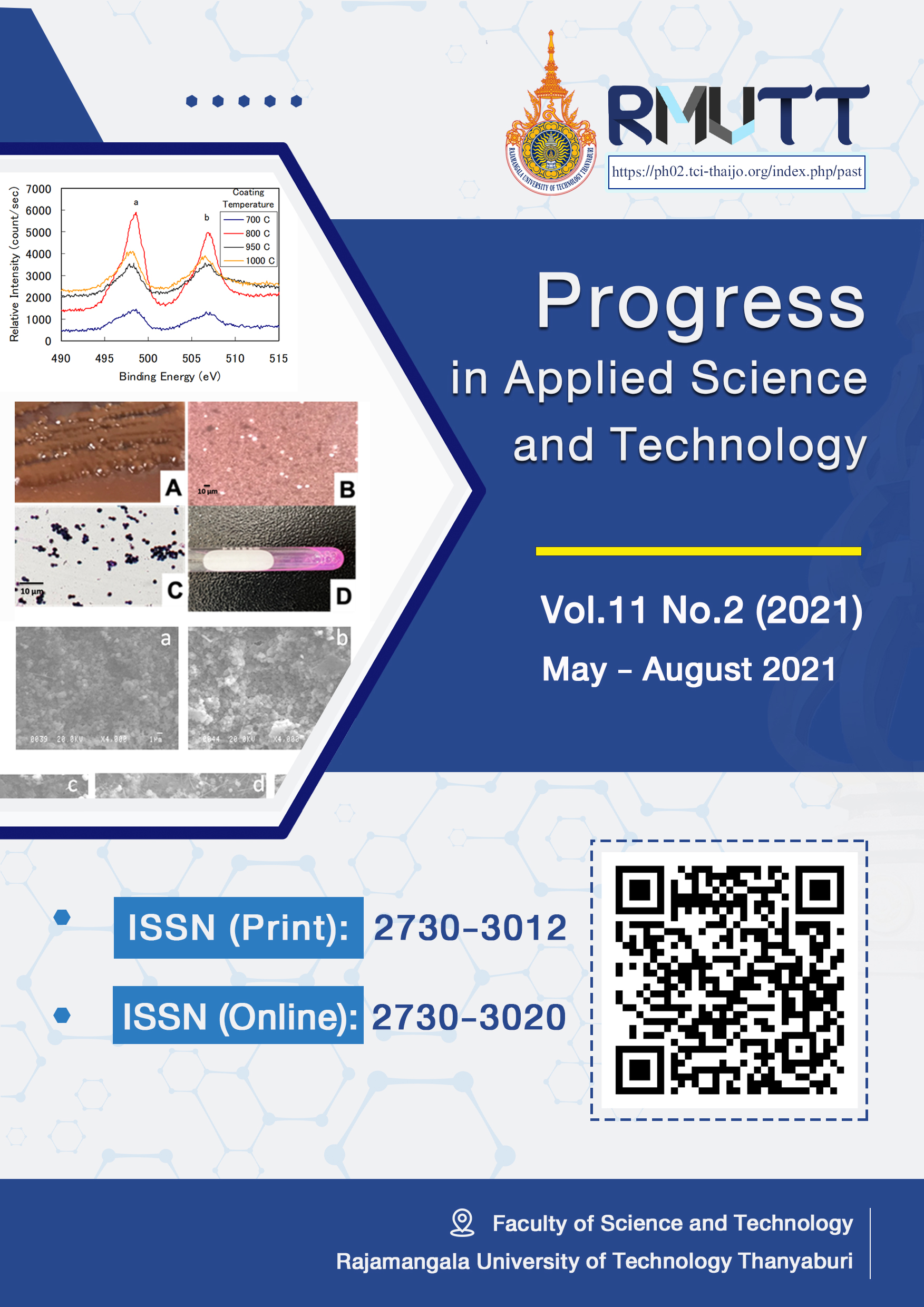Isolation of Cryptococcus neoformans from Pigeon Excreta in Nakhon Ratchasima College, Nakhon Ratchasima Province
Main Article Content
Abstract
Cryptococcosis is an important opportunistic fungal disease in human. The disease is caused by Cryptococcus neoformans which is commonly found in pigeon droppings. The cryptococcal infection can become life-threatening diseases such as meningitis and pneumonia in human, especially in patient with immunodeficiency. This research aimed to determine the prevalence of C. neoformans from pigeon droppings in the area of Nakhon Ratchasima College, Nakhon Ratchasima province. In this study, 84 samples of pigeon droppings were collected from 11 different areas of the college from June to August 2020. The samples were cultured on the sunflower seed medium supplemented with chloramphenicol. The mucoid colonies with brown color formed on the agar media were examined with India ink preparation and Gram stain followed by the colony identification with urease test and matrix-assisted laser desorption/ionization time-of-flight mass spectrometry (MALDI-TOF MS) determination, respectively. One of 84 pigeon droppings (1.2%) was identified as C. neoformans. This pigeon dropping isolate was collected from the area that had the accumulation of large amount of pigeon droppings. The results suggested that the accumulating area of pigeon droppings can become a potential reservoir of cryptococcal infection. Our data provide useful knowledge applied to propose the policy for prevention and control of cryptococcal infection in this college.
Article Details

This work is licensed under a Creative Commons Attribution-NonCommercial-NoDerivatives 4.0 International License.
References
Mada PK, Jamil RT, Alam MU. Cryptococcus. In: StatPearls [Internet]. Treasure Island (FL): StatPearls Publishing; 2020 Jan.PMID: 28613714.
Kwon-Chung KJ, Fraser JA, Doering TL, Wang Z, Janbon G, Idnurm A. Cryptococcus neoformans and Cryptococcus gattii, the etiologic agents of cryptococcosis. Cold Spring Harb Perspect Med. 2014;4(7):a019760.
Andama AO, den Boon S, Meya D, Cattamanchi A, Worodria W, Davis JL. Prevalence and outcomes of cryptococcal antigenemia in HIV-seropositive patients hospitalized for suspected tuberculosis in Uganda. J Acquir Immune Defic Syndr. 2013;63(2):189-94.
Park BJ, Wannemuehler KA, Marston BJ, Govender N, Pappas PG, Chiller TM. Estimation of the current global burden of cryptococcal meningitis among persons living with HIV/AIDS. AIDS. 2009;23(4):525-30.
Nucci M, Queiroz-Telles F, Tobón AM, Restrepo A, Colombo AL. Epidemiology of opportunistic fungal infections in Latin America. Clin Infect Dis. 2010;51(5):561-70.
Warnock DW. Trends in the epidemiology of invasive fungal infections. Nihon Ishinkin Gakkai Zasshi. 2007;48(1):1-12.
Lawrence DS, Boyer-Chammard T, Jarvis JN. Emerging concepts in HIV-associated cryptococcal meningitis. Curr Opin Infect Dis. 2019;32(1):16-23.
Lin X, Heitman J. The biology of the Cryptococcus neoformans species complex. Annu Rev Microbiol. 2006;60:69-105.
Ellis DH, Pfeiffer TJ. Ecology, life cycle, and infectious propagule of Cryptococcus neoformans. Lancet. 1990;336(8720):923-5.
Ellabib MS, Aboshkiwa MA, Husien WM, D'Amicis R, Cogliati M. Isolation, Identification and Molecular Typing of Cryptococcus neoformans from Pigeon Droppings and Other Environmental Sources in Tripoli, Libya. Mycopathologia. 2016;181(7-8):603-8.
Pal M. First Record of Isolation of Cryptococcus neoformans from Pigeon Droppings in Djibouti. Molecular Microbiology Research. 2015;5(3):1-3.
Emmons CW. Saprophytic sources of Cryptococcus neoformans associated with the pigeon (Columba livia). Am J Hyg. 1955;62(3):227-32.
Li A, Nishimura K, Taguchi H, Tanaka R, Wu S, Miyaji M. The isolation of Cryptococcus neoformans from pigeon droppings and serotyping of naturally and clinically sourced isolates in China. Mycopathologia. 1993;124(1):1-5.
Castanón-Olivares LR, López-Martínez R. Isolation of Cryptococcus neoformans from pigeon (Columba livia) droppings in Mexico City. Mycoses. 1994;37(9-10):325-7.
Khosravi AR. Isolation of Cryptococcus neoformans from pigeon (Columba livia droppings in northern Iran. Mycopathologia. 1997;139(2):93-5.
Brito MO, Bessa MAS, Menezes RP, Röder DVDB, Penatti MPA, Pimenta JP. Isolation of Cryptococcus species from the external environments of hospital and academic areas. J Infect Dev Ctries. 2019;13(6):545-53.
Taylor RL, Duangmani C. Occurrence of Cryptococcus neoformans in Thailand. Am J Epidemiol. 1968;87(2):318-22.
Balankura P. Isolation of Cryptococcus neoformans from soil contaminated with pigeon droppings in Bangkok. J Med Assoc Thai. 1974;57(3):158-9.
Soogarun S, Wiwanitkit V, Palasuwan A, Pradniwat P, Suwansaksri J, Lertlum T. Detection of Cryptococcus neoformans in bird excreta. Southeast Asian J Trop Med Public Health. 2006;37(4):768-70.
Tangwattanachuleeporn M, Somparn P, Poolpol K, Gross U, Weig M, Bader O. Prevalence and antifungal susceptibility of Cryptococcus neoformans isolated from pigeon excreta in Chon Buri Province, Eastern Thailand. Med Mycol J. 2013;54(3):303-7.
Sriburee P, Khayhan S, Khamwan C, Panjaisee S, Tharavichitkul P. Serotype and PCR-fingerprints of clinical and environmental isolates of Cryptococcus neoformans in Chiang Mai, Thailand. Mycopathologia. 2004;158(1):25-31.
Cremieux A. Factors affecting the bactericidal action of disinfectants. Implications for selection of resistant strains. Drugs Exp Clin Res. 1986;12(11):899-903.
McDonnell G, Russell AD. Antiseptics and disinfectants: activity, action, and resistance. Clin Microbiol Rev. 1999;12(1):147-79.
Nett JE, Guite KM, Ringeisen A, Holoyda KA, Andes DR. Reduced biocide susceptibility in Candida albicans biofilms. Antimicrob Agents Chemother. 2008;52(9):3411-3.
Krangvichain P, Niyomtham W, Prapasarakul N. Occurrence and susceptibilities to disinfectants of Cryptococcus neoformans in fecal droppings from pigeons in Bangkok, Thailand. J Vet Med Sci. 2016;78(3):391-6.






